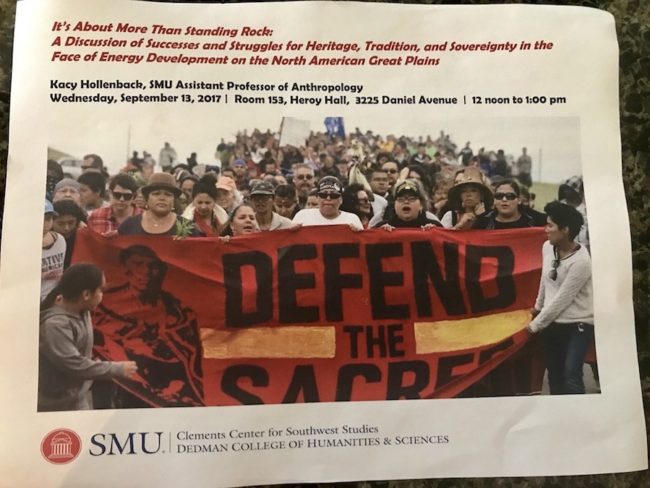
Editor’s note: This story has been updated throughout.
Laws don’t always guarantee protection against energy development on Native American lands, according to SMU Assistant Professor of Anthropology Kacy Hollenback.
About 40 students and faculty members gathered on Wednesday, Sept. 13 in Heroy Hall to hear Hollenback’s lecture, “It’s About More Than Standing Rock,” a presentation on energy development on the North American Great Plains. The professor is an expert on Northern Plains archaeology and anthropology and has worked with a number of American Indian tribes and studying their cultural and communal changes over the past decades.
Most people know about the energy development issue because of the widely covered the Dakota Access Pipeline, a 1,200-mile pipeline from North Dakota to oil refineries in Illinois, built on Indian reservations. The Standing Rock Sioux Nation is an indigenous tribe who have appeared repeatedly in the media for fighting the construction of the pipeline on their tribal lands.
But laws regarding energy development on or near tribal lands of any of the Native American nations don’t guarantee protection against natural heritage. Hollenback’s lecture covered certain tribes such as Standing Rock, Blackfeet, Fort Berthold and others, and how they have been affected by energy development on their reservations.
Laws are sometimes easy to get around because they are “written with words like ‘may,’” Hollenback said.
Anna Braman is a student in one of Hollenback’s class who enjoys hearing lectures related to archaeology. She said she attended this lecture to “hear a slightly different topic than what we hear in class.”
Audience members chatted among themselves before the lecture, many of them eager to hear the professor speak specifically about the Dakota Access Pipeline and its effect on Indian tribes.
“I’ve seen it unfold on the news but I wanted to find out more,” said SMU assistant professor of anthropology Sara Mosher.
Hollenback started her lecture with a reference to a 1980s movie star known for her husky voice, creating laughter among the audience.
“Can everyone hear me? I have a cold and I sound a bit like Kathleen Turner today,” Hollenback said.
But Hollenback’s lecture quickly turned serious as she began to address the issue of why Native American tribes are so upset.
“Students ask me, why are tribes so upset? You have to understand the history, and it’s not a deep history,” she said from the podium, where she had a PowerPoint with photos of her work.
Hollenback broke down the meaning of the word ‘heritage’ into two categories, cultural and natural. She defined cultural heritage as paintings, manuscripts, oral traditions and rituals. Natural heritage consists of sites with cultural aspects like landscapes and physical, biological and geological formations.
The lecture took a political turn when Hollenback discussed President Donald Trump’s approval of the Dakota Access Pipeline.
Hollenback argued on the side of the Sioux protestors that “most people don’t know” that 95 to 99 percent of the pipeline is built on private land.
In addition to building on private land, the government has destroyed sites of cultural and historical significance. Hollenback also provided what she called a staggering statistic: there have been 3,300 reported incidents of leaks and ruptures at oil and gas pipelines since 2010.
Hollenback specifically cited the “Bakken oil boom,” or oil extraction from the Fort Berthold reservation in North Dakota. She played devil’s advocate by stating that energy development has had benefits for the tribe including increased revenue used for vital programs like elder care and childcare. However, crime rates, drug abuse and traffic fatalities have increased.
As the one-hour lecture came to a close, hands shot up all around the audience, and almost 10 people stayed after to speak to the professor.
In an interview after the lecture, Professor Hollenback said, “it’s a double-edged sword, tribes want development. But with development, there’s a possibility people will walk all over them, so how do we protect these places?”








